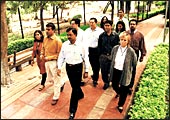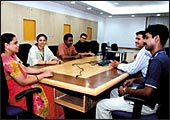 |
| Leading the way: Satyam's Raju (in the
forefront) with his future business leaders |
As the young
head of HR at Satyam Computer Services, Hari Thalapalli (simply
Hari to colleagues) is expected to wear multiple hats. But that
still doesn't explain why he should have a box of Camel Redimix
water colours and chocolate wrappers in one corner of his workstation.
That, he explains with a smile, is a return gift from Aishani
Mishra, the nine-year-old daughter of Lalatendu Mishra, Head of
Delivery for Energy and Utilities vertical. It was her way of
thanking her father's employer for remembering her birthday. Till
the earmarked corner on Hari's table doesn't run out of space,
Mishra's water colours will continue to remind Hari and his team
that, when it comes to bonding, every little gesture counts. "We
need to address the important events in an associate's (or Satyamite's)
life," says Hari, pointing to the soft board in his cabin
that features a list of people whose birthdays fall over the next
15 days.
The exercise, however, is part of a larger plan at work. The
top managers at Satyam (like elsewhere), explains Hari, not just
have business responsibilities, but often must spend a lot of
time away from their families. So, there's a greater need to help
with family bonding. A pilot project launched in June this year
already ensures that for 130 Satyamites at and above the level
of vice president, but now it is being rolled out to the next
level, comprising 700 people (star performers across levels).
Keeping track of everyone's birthday and other special days may
not be a cost-intensive exercise, but Satyam does seem intent
on helping make a difference in the lives of its associates (read:
employees). Last December, for instance, it launched a three-day
global leadership programme for employees' children in the age
group of 12 to 17. "It is not enough for us to be global
leaders, it is important for us to nurture our children to be
global leaders as well," says Hari. In all, 60 children were
brought together for this in Hyderabad (the programme is to be
replicated at other centres), with the objective of helping them
understand themselves, and demonstrating the power of decision-making
and the importance of networking.
SNAPSHOT
REVENUES: Rs 4,634.31
crore (2005-06)
NET PROFIT AFTER TAX: Rs 1,239.75
crore |
Total employees: 30,000
Attrition (per cent): 19.1 (2005-06)
Average career tenure: 3.1 years
Training budget (budgeted/actual): Rs
139.03 crore/146.44 crore
Training man-hours (actual): 2,069,209 |
Not surprisingly, then, Satyam's internal score on its associate
delight index is at 4.28 (on a scale of 5) as against only 3.6
last year. The index is used to gauge how the employees feel about
the organisation based on a variety of parameters, ranging from
performance to communication and infrastructure, among others.
Having a constant finger on the pulse of its workforce is important
for any employer, but more so for Satyam, which, until recently,
had to deal with an attrition rate of 19.1 per cent. (It includes
a performance-based attrition of 3.6 per cent, so the real attrition
is lower. Since Satyam was in the silent period ahead of its second
quarter results, Hari declined to give specific numbers, but said
that things were improving.) The emphasis now, he says, is on
offering job flexibility (which allows employees to choose the
role they want to play), greater work-life balance, and fun at
the workplace. The ultimate idea, Hari explains, is to shift the
focus from teams to independent businesses, from managers and
leaders to CEOs of own businesses, from growth to value, and from
delegation to empowerment.
 |
| A campus to kill for: A deer park at
Satyam's Bahadurpally centre |
Changing Trajectory
From an organisational design perspective, the new initiatives
are aimed at keeping Satyam, which today employs around 30,000,
as nimble as a small firm. "It is built into our organisational
design, which creates a network of value-creating entities,"
says Satyam's Chairman B. Ramalinga Raju. What he is referring
to in specific is a recent move that puts Satyamites literally
in charge of small 'companies' within the bigger corporation.
For instance, Satyam has carved out certain areas within the organisation
and divided them into 1,500 small businesses with 'CEOs' for each
of them. And over the last one year, it has made it possible for
the 'CEOs' to generate monthly profit and loss (P&L) accounts
for almost 1,000 of the 1,500 businesses. The distinguishing feature
of the new system is that employee incentives are now driven more
by how their businesses perform rather than by the organisation's
performance on the whole. Says Vikram Chimalgi, 32, 'CEO' of one
such business unit that caters to a major appliances player in
the US: "It is an end-to-end responsibility. One is involved
right from the estimate of the project to getting the right people
to work on it, ensuring that it is executed in the most cost-effective
manner and can result in profitability for the business."
Earlier, Chimalgi says, his responsibility as a project manager
would begin and end with the timely delivery of the product or
service to the customer.
INTERVIEW/B.
RAMALINGA RAJU/CHAIRMAN, SATYAM COMPUTER SERVICES
"Our Responsibility Today Is To Grow Leaders" |
|
 The
man who came to IT via textiles spoke to BT's E. Kumar
Sharma on Satyam and its people challenges. Excerpts: The
man who came to IT via textiles spoke to BT's E. Kumar
Sharma on Satyam and its people challenges. Excerpts:
What would you say has changed about Satyam over the
last one year?
Satyam has had an inflection point, as we have come of
age and have a certain size (a billion dollar in revenues,
with over 30,000 employees and a greater global presence)
and we now want to move to the next level, which we call
the 6th Orbit. It is about leadership and innovation (the
underlying point being that Satyam has traversed five orbits,
with the last one centred around deepening knowledge in
domain areas and strengths in providing integrated solutions).
How has your own role and that of the senior management
changed in dealing with the people issues?
The responsibility of the senior associates today is to
grow leaders, focus more on integration and getting involved
in shaping the future of not just our organisation but also
of our customers. A greater proportion of our time is now
spent on leadership development. We need to ensure that
we have the right eco-system for value creation.
Attrition, at 19 per cent a year, must be an issue.
How is Satyam dealing with it?
We have seen a reversal in the trend and you must recognise
that there is an element of performance-based (forced) attrition
in this and if you normalise that number, then we are quite
in tune with the trends in the industry.
Satyam has about 30,000 employees today. As the organisation
grows, how do you propose to ensure that the nimbleness
of a small, promoter-driven company is retained?
In a way, that is built into our organisational design,
which creates a network of value-creating entities. The
company has, for instance, carved out within the organisation
1,500 small businesses with each having their own P&L
(profit and loss) account.
|
Analysts who have tracked the company over the years do see
it taking steps to "broaden employee pyramid" and "grow
management depth". A case in point could be the roping in
of Edward S. Cohen, who in 1999 founded consulting firm Booz Allen
Hamilton's Centre for Performance excellence. He is now heading
the newly-founded Satyam School of Leadership, which has Harvard
Business School professor Krishna Palepu as its strategic advisor.
Apparently, the thrust on leadership lower down the line comes
from Raju himself. In all his recent meetings with the HR team,
Raju has asked them to focus on creating a more global outlook
within the organisation. For instance, in their last meeting with
Raju, a team member says, HR discussed issues on how to handle
growth in China, in the new development centres in Central Europe
and Asia Pacific.
A DAY
IN THE LIFE OF
ANUPAMA BUGATHA, 39, Assistant Vice
President (Manufacturing) |
 |
| Taking stock: Bugatha in a meeting
with her project team |
 |
| One-to-one: Taking a coffee break
at the company cafeteria |
 |
| Not yet end of the day: Here she's
discussing the status of invoicing |
After dropping her two kids
at school, Anupama Bugatha is at Satyam's Chennai office
by 9 a.m. Straightaway, she ploughs through the 50-odd e-mails
waiting for her in her in-box. That done, Bugatha gets on
the phone to talk to her accounts department for some invoices
that need to be raised. It's the beginning of the month
and she is busy billing customers for the work done the
previous month. Some of her colleagues from the onsite team
are here today and she goes into a quick meeting with them.
It's an action-packed day, and Bugatha is having a good
time. One reason why she joined Satyam via Sundaram-Clayton
(two years) and TCS (six) was that, back in 1998, "it
was a smaller organisation that was growing rapidly and
one that would offer enough opportunities for growth".
And grow she has. From a project leader back then to an
Assistant Vice President in the manufacturing vertical,
with 150 people reporting to her. A computer science student,
Bugatha now works more like a venture capitalist, responsible
for multiplying 'shareholder' wealth. As you must have guessed,
she, as the 'VC', has five CEOs reporting to her. Their
five units are among the 1,500 entities that are run like
independent businesses with their own P&L accounts.
But Bugatha wants to go farther. She is currently pursuing
an MBA programme sponsored by her employer. So, by half-past
seven in the evening, she's walking out of the office door,
but there may be a call or two to handle later in the evening.
And going by her purposeful strides, you can tell that she's
eager to get back to work.
|
Importantly for Satyam, all its people initiatives seem to be
making a difference. "I think the one thing we have achieved
at Satyam now is making the entire set of people in the company
aware of the business fundamentals. The focus has today shifted
from a culture of manning a project to owning a project,"
says A.S. Murthy, Director and Senior VP (Leadership Development
Group). This is accomplished partly by an in-house handbook called
'SatyamWay', which forms the welcome kit for new employees and
explains Satyam's business fundamentals, and its aspirations and
goals. The Leadership Development Group was created in April this
year to give greater focus to leadership development. Murthy,
who was earlier heading HR, was made its head and reports directly
to Chairman Raju.
Like Hari points out, "It is important to generate business
leaders at a pace that matches the business growth (which is 30
per cent per annum)". Globally, he says, the industry tends
to have only 50 per cent of the business leaders it needs at any
given point. Satyam's attempts at creating 1,500 business leaders,
then, seems like a good strategy. Retaining them will require
an even better strategy.
|







 The
man who came to IT via textiles spoke to BT's E.
The
man who came to IT via textiles spoke to BT's E. 

